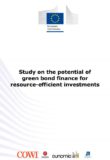A study released by the European Commission yesterday shows that green bonds have enjoyed extraordinary growth, since they were first issued in 2007. The study on the potential and functioning of green bond markets also identifies key bottlenecks and measures to overcome them so they can fulfil their huge potential. The study comes out two days after the Commission’s “Clean Energy for All Europeans” package which finds that an extra EUR 177 billion is needed annually from 2021 onwards to reach the 2030 climate and energy goals. New innovative funding and investment mechanisms will be essential to achieve this. Green bonds will also be on the agenda of the High Level Expert Group on sustainable finance that the Commission established on 28 Oct 2016.
Vice-President Valdis Dombrovskis, responsiblefor the Euro and Social Dialogue, also in charge of Financial Stability, Financial Services and Capital Markets Union, said: “Promoting long-term and green finance is one of the priorities of the Capital Markets Union Action Plan. Green bonds are an important instrument to raise capital market finance for environmentally-friendly and more sustainable investments. The new High Level Expert Group on sustainable finance will help define steps towards greener capital markets.”
Commissioner for Environment, Maritime affairs and Fisheries, Karmenu Vella, said: “EU has positioned itself well, to allow companies and municipalities to be among the frontrunners in the expanding green bond market. We must double our efforts to eliminate existing bottlenecks. This will allow green bonds to help on investment needed to move towards a circular economy and fulfil our energy and climate commitments.”
In 2012 USD 2.6 billion of green bonds were issued globally. By 2015 total issuance had multiplied to USD 41.8 billion. It rose to USD 74.3 billion by end of November 2016. European and Chinese issuers make up largest share of the climate-aligned bonds market globally. In Europe, France and UK are the biggest issuers. In light of the global commitment to shift to a low carbon economy, the green bond market is likely to continue to grow, attracting more diverse issuers and investors. It can be an additional source of long-term green financing next to bank lending and equity financing.
The study identifies the lack of green project pipelines as well as the absence of a green bonds definition and framework as holding back development. But there are many good practices in EU Member States and beyond to overcome these and other limitations. Examples of public sector measures range from ‘soft measures’ such as raising awareness and capacity building to more stringent approaches such as mandatory disclosure of green indicators for bond issuances and investments.
The study also looked into standardisation. Many stakeholders stress the importance of standards to ensure that the proceeds from green bonds are used for genuinely green projects with clear and measurable environmental objectives. Market-led initiatives are developing strongly in this area. The study advises supporting a common European Green Bonds Standard building on existing market-led initiatives.
Today, green bonds mainly finance projects in renewable energy (45.8% of the issuance globally in 2015), energy efficiency (19.6%), low carbon transport (13.4%), sustainable water (9.3%), and waste & pollution (5.6%). Green bonds are thus one important financing instrument to deliver on the ambitions of the Energy Union Package “Clean Energy for all Europeans“, published on 30 November 2016.
Background
A green bond is differentiated from a regular bond by its label, which signifies a commitment to exclusively use the funds raised to finance or re-finance “green” projects, assets or business activities. Green projects are projects that promote progress on environmentally sustainable activities. Green bonds provide an opportunity to mobilize capital for green investments helping investors to make informed and explicit decisions. Green bonds are a means of attracting new investors and hence mobilizing liquidity for green investments.
Milestones in the evolution of the green bond market:
- The green bond market emerged in 2007-08 with the first few issuances by Multilateral Development Banks.
- Private sector issuers, including corporates and banks joined the market in 2013-2014, supported by the launch of the Green Bond Principles. From 2013, there was a surge in the issuance of labelled green bonds.
- More countries joined the green bond market in 2015. Corporate green bonds accounted for 36% of the issuance – the highest share ever, followed by municipalities with 15% and by banks with 12%.






